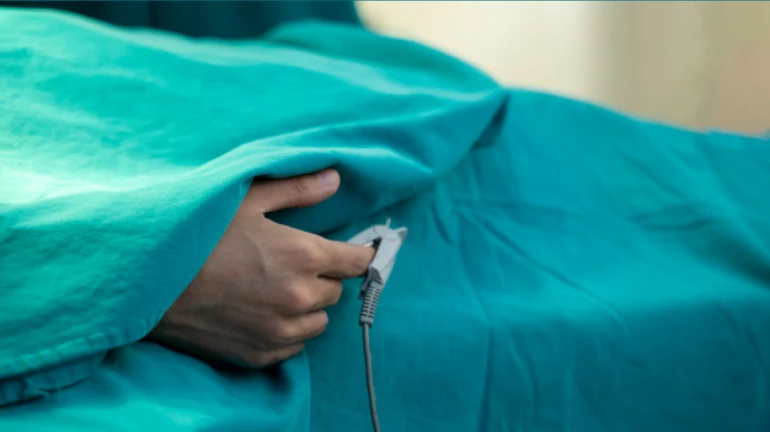
Two 85-year-old patients successfully underwent the Transcatheter Aortic Valve Replacement (TAVR) procedure in Mumbai. The advanced procedure was performed by a team led by Dr. Ganesh Kumar, Head of Department Cardiology, Senior Consultant Interventional Cardiologist, Dr. L.H. Hiranandani Hospital, Mumbai.
Aortic Valve Stenosis, natural degeneration of aortic valve with age, is a condition of the heart in which the aortic valve, responsible for blood flow to the rest of the body, doesn’t fully open, thus reducing or blocking blood flow to the body. Severe Aortic Valve Stenosis can lead to death.
One of the less known heart conditions among elderly people is Aortic Valve Stenosis — or Aortic Stenosis which is narrowing of the heart's aortic valve with age. Aortic valve helps in controlling the blood flow to the body. When this valve gets stenosed, it prevents the valve from opening fully, and thereby obstructing the blood flow from the heart into the main artery of the body.
The life expectancy at birth in India in 2019 was 69.5 years for men and 72 years for men, which was much less a decade back. With increasing Life expectancy, the degenerative Aortic Stenosis (the normal aortic valve degenerates and narrows with age) is going to a burden in the society. Approximately 5-7% of the population above 65 years suffers from degenerative Aortic Valve Stenosis. More than 60 lakh population may be suffering from Aortic valve disease and require this treatment.
A person with such condition may experience chest pain, shortness of breath, fatigue, the heart becomes weaker and sometimes, they may even pass out. Unfortunately, by the time it is found in many patients, the disease has progressed to an advanced stage.
India has been epicenter of advancement in healthcare and but we have seen incidences with heart conditions increasing significantly at all age groups. Over the last 10 years, the trans-catheter aortic valve replacement (TAVR), is performed non-surgically in the cath lab, where it has actually replaced the open heart surgery by reducing the risk of life and being minimum invasive.
COVID has further exacerbated this problem. Due to fear of being exposed to coronavirus, a lot of people especially elderly age group put off doctor visits and check-ups and this does more harm than good as their diagnosis gets delayed. Due to this delay, it can lead to heart failure (the main pumping chamber of the heart know as left ventricle eventually loses markedly its pumping capacity and fails to pump blood across the narrowed aortic valve). This heat failure hastens death. Hence, these patients need to be attended and their valves need to be replaced before the efficiency of their left ventricle goes down or loses its pumping capacity.
Traditionally, the only treatment option for Aortic Valve Stenosis used to be open heart surgery, which involved surgically gaining access to the heart and temporarily switching over its functioning to a machine while the surgeon operated on the organ. While effective, this is a highly invasive procedure and requires intensive post-surgical care and takes a huge toll on the body, particularly in the case of older patients.
“The two patients had come to us with severely decreased pumping capacity and wee in advanced heart failure. Both patients avoided early visits to hospital due to fear of contracting COVID-19. Considering their age, we immediately ruled out Open Heart Surgery on account of its invasiveness and toll on the body and opted for TAVR,” said Dr. Ganesh Kumar, remembering both cases. “Transcatheter Aortic Valve Replacement is a newer, much less invasive alternative which does not involve opening up the chest cavity and access to the heart is instead gained via a small blood vessel in the leg using advanced imaging techniques. TAVR requires a shorter hospital stay and recovery is much faster. It required a considerably shorter procedure time, causes minimal discomfort and provides an overall better quality of life,” the doctor added.
Jaya Sitharaman, an 85-year-old woman with diabetes started experiencing sleeplessness, breathing difficulties. It was found that her left ventricle functioning had dropped down to 20%. She was recommended the TAVR procedure.
“My procedure was successful and I was discharged soon after the surgery,” said Sitharaman. “I no longer face any breathing issues and can efficiently perform my day-to-day activities,” she added.
Manikrao Bhamble is an 85 year old ex-minister who hails from the city of Parbhani in Maharashtra. He used to suffer from breathlessness after walking short distances. On diagnosis, it was found that the valve in his heart was functioning at just 19% of its capacity.
“After a successful procedure, I was able to walk by myself that very evening and now my condition is much better. I am able to move around for longer periods of time on my own, can perform daily activities & is also able to have good sleep without any hindrances.,” said Mr. Bhamble
His son, Pramod Bhamble, said, “Considering my father’s age and the severity of his illness, we had given up hope. We are grateful to Dr. Ganesh Kumar and the entire staff of Dr. L.H. Hiranandani Hospital for saving my father’s life.”
“TAVR has the potential to replace open heart surgery as the first choice or treatment for Aortic Valve Stenosis for older people with Aortic Stenosis and because of its minimally invasive nature it is safer than open heart surgery and can be opted by older people,” remarked Dr. Kumar.
Doctors, trained in this procedure are heading up this cause across India by visiting various cities in the country, educating people and training other doctors, to make people aware about this potentially life-saving alternative.
Through such sustained efforts, TAVR is likely to become much more accessible to people in the next five years.





